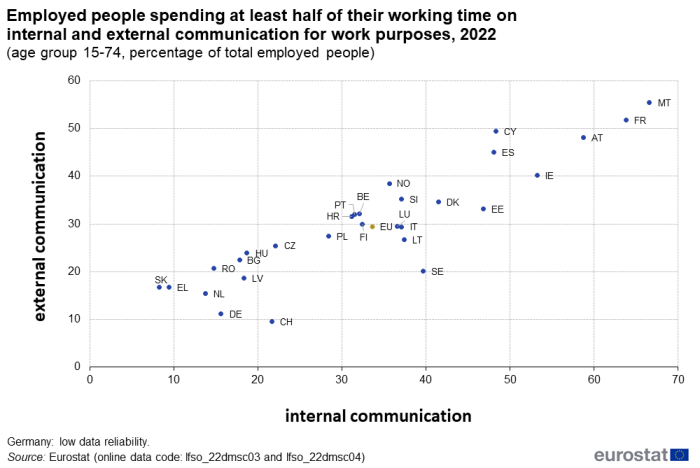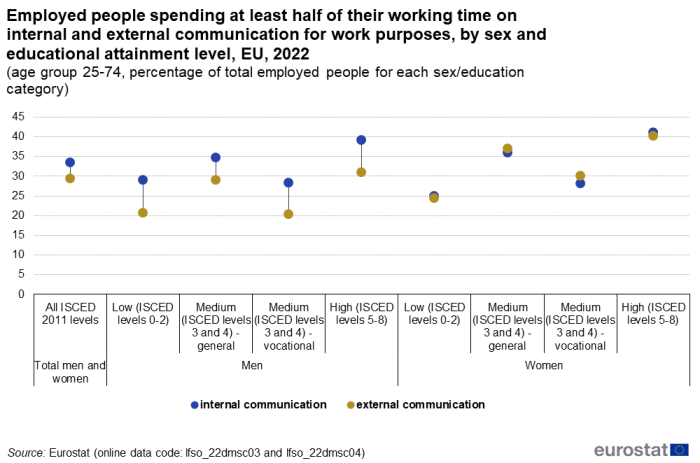Employment statistics - focus on communication skills
Data extracted in October 2023
No update foreseen since data are based on an ad hoc subject module.
Highlights
The highest shares of employed people who spent at least half of their working time interacting with other people, either internally or externally, were found in the sectors of: 'Financial and insurance activities', 'Education', and 'Accommodation and food service activities'.
In the 15-29 age group, women use their communication skills more than men: 39.6 % reported dedicating half or more of their working time to external communication, compared with 24.2 % of men.
This article expands on the information from the article 'Employment statistics - utilisation of job skills' by focusing specifically on the utilisation of communication skills. The objective is to address how much working time employed people allocate to work-related communication.
The statistics presented in this article are derived from the ad hoc subject module on job skills conducted as part of the EU labour force survey (EU-LFS) in 2022. The data encompass the European Union (EU), its Member States, and two European Free Trade Association (EFTA) countries, Norway and Switzerland.
Full article
Tasks involving social skills
Figure 1 illustrates the distribution of employed people according to their working time allocated to social tasks. Social tasks encompass interactions involving verbal communication for work-related purposes, either within the business or organisation (referred to as internal communication) or with individuals outside of them (external communication). An 'interaction' in this context refers to a situation where two or more people engage in simultaneous communication. This includes face-to-face conversations and phone calls or video calls; written forms of communication, such as text messages or emails are not considered.
In 2022, over two thirds of people aged 15 to 74 years in Malta, France, Austria, and Cyprus spent at least half of their working time on social tasks. The proportion was below a quarter in Latvia, Germany, Greece, and Slovakia. For the EU as a whole, 45.3 % spent at least half of their working time on social tasks.

Source: Eurostat (lfso_22aswt05)
Figure 2 focuses on different sectors of economic activity (NACE Rev. 2) at EU level. The largest proportions of employed people who spent at least half of their working time interacting with others were found in the sectors of 'Financial and insurance activities', 'Education', and 'Accommodation and food service activities'. At the same time, over 40 % of people employed in the sectors 'Mining and quarrying', 'Activities of households as employers', and 'Agriculture, forestry and fishing', declared that they spent little or none of their working time on social interaction.

Source: Eurostat (lfso_22aswt06)
Internal versus external communication
The previous section presented information on the amount of working time spent on internal and external communication, aggregated under the common notion of social tasks. This section analyses in further detail these social tasks, distinguishing between the two types of communication - internal and external. Please note that people can be simultaneously involved in both or just one of those types of communication, depending on their specific working situation.
Figure 3 indicates a strong positive correlation at country level between the percentage of employed people dedicating half or more of their working hours to internal communication and the corresponding percentage for external communication. Malta, France, Cyprus, Austria, Spain, and Ireland showed high values for both percentages, while Slovakia, Greece, the Netherlands, Germany and Switzerland recorded low values. In the EU as a whole, 33.6 % of employed people declared that they spent at least half of their working time on internal communication, while 29.5 % reported spending the same amount of working time on external communication.

Source: Eurostat (lfso_22dmsc03) and (lfso_22dmsc04)
The percentage of employed men allocating at least half of their working time to internal communication exceeds significantly that of external communication, except for the age group 60-74 years, which had similar shares (see Figure 4). This difference is particularly prominent among men aged 15-29 years, with 34.6 % for internal communication compared with 24.2 % for external communication (10.3 percentage points difference).
The pattern for women was different. Except for the age group 30-44 years, women's percentages for external communication were slightly above those for internal communication. Only among women aged 60 to 74 years was there a relatively large gap between the categories of communication (with external communication being 5.2 percentage points higher).
In addition, the percentages of men spending at least half of their working time on internal and external communication peak in the age group of 30-44 years. Subsequently, these percentages decline for the age groups 45-59 and 60-74 years. In contrast, women recorded their highest communication percentages at a younger age, in the age group 15-29 years.
Overall, more women than men dedicated at least half of their working time to communication, except for two instances regarding internal communication. Men and women aged 45 to 59 had equal shares, and men aged 60-74 years showed a higher percentage than their female counterparts.
The most significant difference between sexes was observed among people aged 15-29 years, specifically in external communication. Among employed women in this age group, 39.6 % reported dedicating at least half of their working time to external communication. In comparison, the corresponding percentage for men was 24.2 %.

Source: Eurostat (lfso_22dmsc03) and (lfso_22dmsc04)
Figure 5 displays data by level of education for the age group 25-74 years. Among men, those with a medium vocational education exhibited the lowest levels of communication, both internal and external. Among women, those with a low level of education engaged the least in both types of communication in their work. Those with a high level of education, regardless of their sex, showed the highest percentages. People with a medium general education also recorded relatively high shares, close to those with a high level of education.

Source: Eurostat (lfso_22dmsc03) and (lfso_22dmsc04)
Figure 6 shows the top 15 occupations (ISCO-08 two-digit level) where a significant share of people devoted at least half of their working time to internal communication. The first seven occupations belong to the major groups of 'Managers' and 'Armed Forces', encompassing occupations such as non-commissioned armed forces officers, administrative and commercial managers, armed forces occupations (other ranks), production and specialised services managers, chief executives, senior officials, and legislators - occupations where men represent the predominant share of persons employed.
Finally, Figure 7 shows the top 15 occupations according to the proportion of people spending at least half of their working time on external communication. Sales workers have the highest share, followed by customer service clerks, hospitality, retail and other services managers, and health and teaching professionals. Women represent the majority employed in these occupations, except within the hospitality, retail and other services managers.
Source data for tables and graphs
Data sources
The European Union Labour Force Survey (EU-LFS) is the largest European household sample survey providing quarterly and annual results on labour market characteristics of people. EU-LFS covers the resident population, defined as all people usually residing in private households.
Since 1999, an inherent part of EU-LFS has been the modules. These were called 'ad hoc modules' until 2020. From 2021 onwards, they are called either 'regular modules' when the variables have an 8-yearly periodicity or 'modules on an ad hoc subject' for variables not included in the regular datasets. In 2022, EU-LFS included an ad hoc subject module on job skills.
To ensure a clear differentiation between the working time spent using digital devices (module variable DIGITAL) and the working time dedicated to interaction with other people (variables COMMINT and COMMEXT), written interactions, such as instant text messages and emails, were excluded from the scope of the communication-related variables. These activities should be reported within the DIGITAL variable. Results regarding the working time spent using digital devices, can be found in the article 'Employment statistics - utilisation of Job Skills'.
For further information on the EU-LFS modules, please refer to the article EU labour force survey - modules on this subject.
Coverage: The 2022 EU-LFS module on job skills covers all European Union Member States and the EFTA Member States Norway and Switzerland. For Cyprus, the survey covers only the areas of Cyprus controlled by the Government of the Republic of Cyprus.
All figures in this article refer to the main job of employed people.
European aggregates: EU and EU-27 refer to the sum of the 27 EU Member States.
Educational attainment refers to the highest level of education successfully completed. Educational levels are defined and classified according to the International Standard Classification of Education, 2011 version (ISCED 2011).
In this article, low level of education refers to ISCED levels 0-2 (less than primary, primary and lower secondary education), medium level refers to ISCЕD levels 3 and 4 (upper secondary and post-secondary non-tertiary education) and high level of education refers to ISCED levels 5-8 (tertiary education). The medium level is split into general and vocational.
General education is defined as education programmes that are designed to develop learners' general knowledge, skills and competencies, as well as literacy and numeracy skills, often to prepare participants for more advanced education programmes at the same or a higher ISCED level and to lay the foundation for lifelong learning.
Vocational education is defined as education programmes that are designed for learners to acquire the knowledge, skills and competencies specific to a particular occupation, trade, or class of occupations or trades. Such programmes may have work-based components (e.g. apprenticeships, dual-system education programmes).
For more information about the distinction between general and vocational education, please consult paragraphs 53 to 55 of ISCED 2011.
Calculation of percentages
All of the figures in this article present percentages of a total. The calculation of all percentages used in this article is based on a total excluding the number of people classified in the non-response category. As such, all exhaustive breakdowns presented in the figures should sum to 100 % (allowing for rounding errors).
Country notes
The specific national formulation of the question about external communication (module variable COMMEXT) in Germany and Switzerland and the question about internal communication (variable COMMINT) in Germany might have led to a lower incidence of people selecting 'All or most of the working time' and 'Half of the working time or slightly more' in their responses. Consequently, caution is advised when interpreting the results for COMMINT and COMMEXT in Germany, as well as for COMMEXT in Switzerland.
Context
To promote a growth mindset towards reskilling and upskilling, 2023 has been designated as the European Year of Skills. The goal is to equip people with the necessary skills to secure relevant, high-quality jobs.
Direct access to
Dedicated section
Methodology
Publications
- Labour force survey in the EU, EFTA and candidate countries — Main characteristics of national surveys, 2020, 2022 edition
- Quality report of the European Union Labour Force Survey 2020, 2022 edition
- EU labour force survey — online publication
ESMS metadata files and EU-LFS methodology
- Employment and unemployment (Labour Force Survey) (ESMS metadata file — employ_esms)
- LFS ad-hoc modules (ESMS metadata file — lfso_esms)


